【struts2+hibernate+spring项目实战】Spring计时器任务 Spring整合JavaMail(邮件发送)(ssh)
一、常用数据频度维护
对于系统使用度较高的数据,客户在查看时希望这些数据最好先出现,此时需要为其添加排序规则。在进行排序时,使用次数成为排序的依据。因此需要设置一个字段用来描述某种数据的使用次数,也就是所谓的使用频度。
本系统中,商品数据是整体数据流的核心数据,为商品数据添加频度字段。

该字段的值默认为0,每使用一次,将其值自增一。但是如果每次使用都修改该表的对应字段,操作量无疑是巨大的,并且还牵扯到数据库操作的隔离级问题,需要防止并发带来的错误操作。
系统中经常会出现此类任务,即需要修改某些数据的值,但是此数据并不需要具有很强的即时性。只需要在某一个特定时刻,将该值修改即可。
基于上述分析,需要一种机制保障,在特定时间点,将对应商品的使用次数修改为当前已使用的总次数即可。最终数据排序时,以该字段作为排序依据即可。
上述问题需要完成两个任务即可
- 规定时间内循环执行某任务
- 执行特殊的SQL语句,完成修改使用次数字段的任务
二、Spring定时作业调度
Spring提供了定时器任务,用于在规定时间执行对应的任务。
1.定义定时作业任务Bean,及其作业任务对应的操作
/**
* 设备一数据插入(小时)
*/
public void insertHourService1(){
realmEbi = (RealmEbi) ApplicationContextUtil.getBean("realmEbi");
realmEbi.insertHour(RealmApplianceModel.sendData3);
}
2.将其配置为Spring管理的Bean
<!-- 定义一个定时bean --> <bean id="timerTask" class="org.sihai.soilmoni.soilrealm.web.SoilRealmAction"> </bean>
3.定义作业任务
<!-- 设备二数据定时插入(天) -->
<bean id="jobTask4" class="org.springframework.scheduling.quartz.MethodInvokingJobDetailFactoryBean">
<property name="targetObject" ref="timerTask"/>
<property name="targetMethod" value="insertDayService2"/>
</bean>
4.定义作业任务的执行时间周期
<bean id="doTime4" class="org.springframework.scheduling.quartz.CronTriggerBean">
<property name="jobDetail" ref="jobTask4"/>
<property name="cronExpression" value="0 59 23 * * ?"/>
</bean>
5.设置该任务加入定时任务
<bean class="org.springframework.scheduling.quartz.SchedulerFactoryBean">
<property name="triggers">
<list>
<ref bean="doTime"/>
<ref bean="doTime2"/>
<ref bean="doTime3"/>
<ref bean="doTime4"/>
</list>
</property>
</bean>
6.修改执行的时间周期值,参看:资源/定时调度Quartz/Cron表达式.txt
设置执行周期为每10秒一次 0/10 * * * * ? 每10秒一次 0/10 * * ? * * 每10秒一次
7.源码
<?xml version="1.0" encoding="UTF-8"?>
<beans xmlns="http://www.springframework.org/schema/beans"
xmlns:xsi="http://www.w3.org/2001/XMLSchema-instance"
xsi:schemaLocation="
http://www.springframework.org/schema/beans
http://www.springframework.org/schema/beans/spring-beans.xsd
">
<bean class="org.springframework.scheduling.quartz.SchedulerFactoryBean">
<property name="triggers">
<list>
<ref bean="doTime"/>
<ref bean="doTime2"/>
<ref bean="doTime3"/>
<ref bean="doTime4"/>
</list>
</property>
</bean>
<!-- 作业任务 -->
<bean id="doTime" class="org.springframework.scheduling.quartz.CronTriggerBean">
<property name="jobDetail" ref="jobTask"/>
<property name="cronExpression" value="0 59 23 * * ?"/>
</bean>
<bean id="doTime2" class="org.springframework.scheduling.quartz.CronTriggerBean">
<property name="jobDetail" ref="jobTask2"/>
<property name="cronExpression" value="0 59 23 * * ?"/>
</bean>
<bean id="doTime3" class="org.springframework.scheduling.quartz.CronTriggerBean">
<property name="jobDetail" ref="jobTask3"/>
<property name="cronExpression" value="0 59 23 * * ?"/>
</bean>
<bean id="doTime4" class="org.springframework.scheduling.quartz.CronTriggerBean">
<property name="jobDetail" ref="jobTask4"/>
<property name="cronExpression" value="0 59 23 * * ?"/>
</bean>
<!-- 定义作业任务 -->
<!-- 设备一数据定时插入(小时) -->
<bean id="jobTask" class="org.springframework.scheduling.quartz.MethodInvokingJobDetailFactoryBean">
<property name="targetObject" ref="timerTask"/>
<property name="targetMethod" value="insertHourService1"/>
</bean>
<!-- 设备二数据定时插入(小时) -->
<bean id="jobTask2" class="org.springframework.scheduling.quartz.MethodInvokingJobDetailFactoryBean">
<property name="targetObject" ref="timerTask"/>
<property name="targetMethod" value="insertHourService2"/>
</bean>
<!-- 设备一数据定时插入(天) -->
<bean id="jobTask3" class="org.springframework.scheduling.quartz.MethodInvokingJobDetailFactoryBean">
<property name="targetObject" ref="timerTask"/>
<property name="targetMethod" value="insertDayService1"/>
</bean>
<!-- 设备二数据定时插入(天) -->
<bean id="jobTask4" class="org.springframework.scheduling.quartz.MethodInvokingJobDetailFactoryBean">
<property name="targetObject" ref="timerTask"/>
<property name="targetMethod" value="insertDayService2"/>
</bean>
<!-- 定义一个定时bean -->
<bean id="timerTask" class="org.sihai.soilmoni.soilrealm.web.SoilRealmAction">
</bean>
</beans>
三、常用数据频度维护
使用Spring数据频度调度维护,配置需改数据操作,完成商品使用量频度维护
1.定义维护商品使用频度的SQL语句,执行并验证执行效果
update tbl_goods g set g.useNum = (select count(odm.uuid) from tbl_detail_order odm where odm.goodsUuid = g.uuid)
2.将上述任务转化为定时任务方法
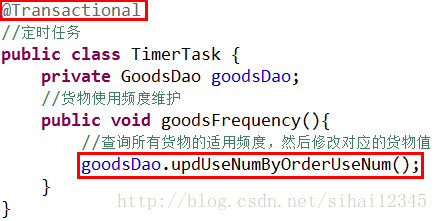
注入对应的数据层Bean,并开启事务
3.设置该任务的执行周期

四、库存预警功能
库存预警功能是对库存商品数量进行报警的一种机制。当库存商品数量高于或低于指定的预警数量时,产生报警信息。
报警信息可以是如下方案之一
- 发邮件
- 发短信
- 给手机发送消息
- 发出警报消息(ERP系统内发送给主管:主管再将该任务派发到人员:实现方式ServletContext范围内的数据共享,创建集合(必须是多线程安全的)页面设计定时器定时获取该集合数据,每隔一段时间发送AJAX请求,获取预警信息
报警操作必须时刻监控库存商品的数量。如果到达报警临界值,进行指定方式的信息报警。此处使用Email形式进行报警。
1.设置报警定时器任务,当库存商品总数量低于最低值或高于最高值时,发送Email到仓库管理员,进行预警报警。

2.设置库存预警定时作业调度任务
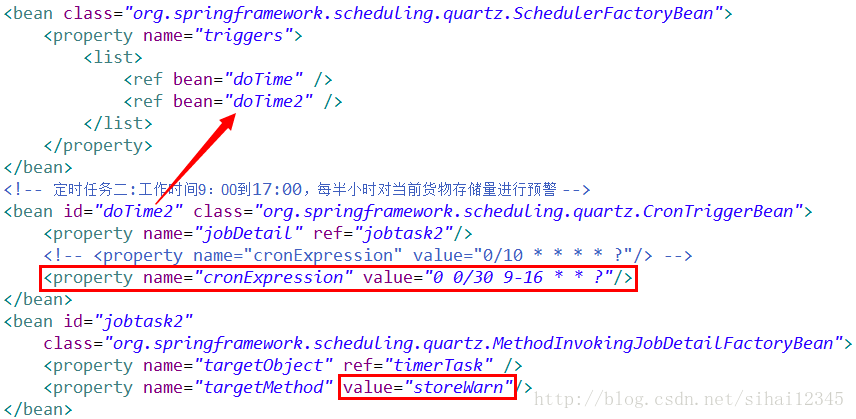
3.测试定时作业是否成功
4.获取引发预警信息的数据
对库存明细数据进行分组统计求和,如果数量超出对应商品的库存预警值,将该商品加入库存预警信息
select
gm.uuid,
gm.goodsName,
sum(sdm.now)>=gm.maxNum ,
sum(sdm.now)<=gm.minNum
from
tbl_detail_store sdm,
tbl_goods gm
where
sdm.goodsUuid = gm.uuid
group by
sdm.goodsUuid
5.获取数据后判断是否需要发送库存预计信息
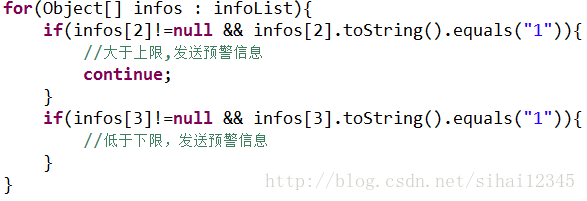
五、Spring整合JavaMail
Spring提供对JavaMail的整合技术,配置JavaMail发送器为Spring管理的Bean,实现Spring管理资源的机制。
1.配置Spring管理的JavaMail发送器对象
<?xml version="1.0" encoding="UTF-8"?>
<beans xmlns="http://www.springframework.org/schema/beans"
xmlns:xsi="http://www.w3.org/2001/XMLSchema-instance"
xmlns:p="http://www.springframework.org/schema/p"
xmlns:context="http://www.springframework.org/schema/context"
xmlns:tx="http://www.springframework.org/schema/tx"
xmlns:aop="http://www.springframework.org/schema/aop"
xsi:schemaLocation="http://www.springframework.org/schema/beans
http://www.springframework.org/schema/beans/spring-beans.xsd
http://www.springframework.org/schema/aop
http://www.springframework.org/schema/aop/spring-aop.xsd
http://www.springframework.org/schema/tx
http://www.springframework.org/schema/tx/spring-tx.xsd
http://www.springframework.org/schema/context
http://www.springframework.org/schema/context/spring-context.xsd">
<description>JavaMail的配置文件</description>
<!-- 加载mail.properties配置文件 -->
<context:property-placeholder location="classpath:mail.properties"/>
<!-- 简单消息对象创建 -->
<bean id="mailMessage" class="org.springframework.mail.SimpleMailMessage">
<property name="from" value="${mail.from}"></property>
</bean>
<!-- 2.创建发送器 -->
<bean id="mailSender" class="org.springframework.mail.javamail.JavaMailSenderImpl">
<property name="host" value="${mail.host}"></property>
<property name="username" value="${mail.username}"></property>
<property name="password" value="${mail.password}"></property>
<property name="defaultEncoding" value="UTF-8"></property>
<property name="javaMailProperties">
<props>
<prop key="mail.smtp.auth">true</prop>
<prop key="mail.debug">true</prop>
<prop key="mail.smtp.timeout">0</prop>
</props>
</property>
</bean>
</beans>
2.设置发送邮件相关内容
//spring整合javaMail需要注入:
private SimpleMailMessage mailMessage;
private JavaMailSender mailSender;
public void setMailMessage(SimpleMailMessage mailMessage) {
this.mailMessage = mailMessage;
}
public void setMailSender(JavaMailSender mailSender) {
this.mailSender = mailSender;
}
public void saveOrUpdate(final User entity) {
if(UtilFuns.isEmpty(entity.getId())){
//判断id是否有值
//说明id没有值,说明保存
entity.setState(1); //1代表可用
String id = UUID.randomUUID().toString();
entity.setId(id);
entity.getUserinfo().setId(id);
//设置初始密码 需要将默认的密码加密后保存到数据库
entity.setPassword(Encrypt.md5(SysConstant.DEFAULT_PASS, entity.getUserName()));
//final就是延长对象的生命周期,不然entity只能在saveOrUpdate中使用,使用完成后方法弹栈,而run方法内就无法再使用之前定义好的entity。
//使用spring与javaMail实现新员工入职时邮件的发送
//使用线程并try-catch的目的就是如果邮件发送失败,也不影响信息保存到数据库。邮件发送成为了一个独立的过程。
Thread th = new Thread(new Runnable(){
public void run(){
try {
mailMessage.setTo(entity.getUserinfo().getEmail());
mailMessage.setSubject("新员工入职信息");
mailMessage.setText("欢迎"+entity.getUserinfo().getName()+"加入廊坊思创志远科技有限公司,您在公司的账号:"+entity.getUserName()+",密码:"+SysConstant.DEFAULT_PASS);
mailSender.send(mailMessage);
} catch (MailException e) {
e.printStackTrace();
}
}
});
th.start();
}
baseDao.saveOrUpdate(entity);
}
3.设置发送邮件的消息内容
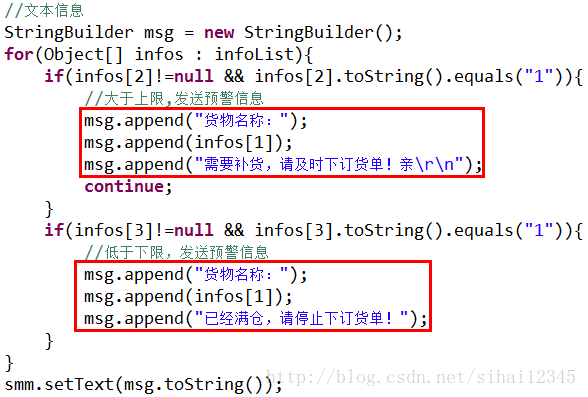
4.发送邮件
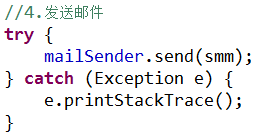
如果想获取更多源码或者视频教程,欢迎关注我的微信公众号 好好学java ,在公众号里,回复: java基础、html5、javaEE基础、struts2、spring、redis、luncene、oracle 等,将可获得以上的优质视频教程及源码。

- 本文标签: 统计 description UI trigger App IO ssh java基础 ip cat Word 多线程 Property XML id classpath entity 科技 配置 Job CTO bean java final servlet 线程 生命 管理 message Select 希望 测试 src tar map JobDetail 时间 constant spring list http 数据库 redis 微信公众号 DOM AOP web schema sql Quartz HTML5 Service value mail ask Oracle 数据 CronTrigger HTML Struts2 update Ajax https 安全 ACE SDN Action key bug 源码
- 版权声明: 本文为互联网转载文章,出处已在文章中说明(部分除外)。如果侵权,请联系本站长删除,谢谢。
- 本文海报: 生成海报一 生成海报二











![[HBLOG]公众号](https://www.liuhaihua.cn/img/qrcode_gzh.jpg)

